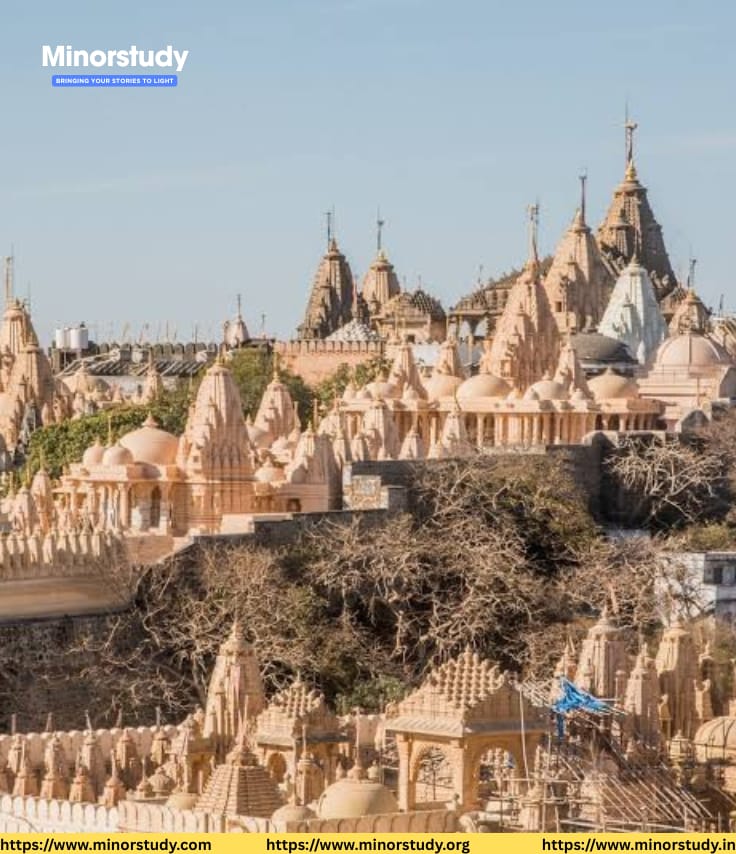🛕 13 Unforgettable Reasons Why Shatrunjaya Hills Remain Jainism’s Most Sacred Spiritual Triumph
High above the city of Palitana in Gujarat, the majestic Shatrunjaya Hills rise in serene splendor. For centuries, these sacred hills have whispered the timeless message of peace, penance, and liberation to those willing to climb their path of devotion.
- 📖 What Are the Shatrunjaya Hills?
- 📜 History of Shatrunjaya Hills
- 🗓️ Timeline: Major Events
- 🌟 13 Fascinating Facts About Shatrunjaya Hills
- ❓ Frequently Asked Questions (FAQs)
- 🕉️ Spiritual and Cultural Significance
- 💡 Importance in Our Daily Lives
- 🙌 Observance and Pilgrimage Rituals
- 🌼 Wishing on Shatrunjaya Hills
- 📌 Important Points Summary
- 🌍 Impact on Society
- 💬 Conclusion: Climb Not Just the Hill, But Your Soul
Whether you’re a Jain follower, a spiritual seeker, or a cultural enthusiast, Shatrunjaya Hills will leave you transformed, not just informed. This article explores their rich history, incredible facts, significance, societal impact, and more — with a friendly, human tone to inspire your own journey inward.
📖 What Are the Shatrunjaya Hills?
Shatrunjaya, meaning “Place of Victory,” refers to the spiritual victory over inner passions. Situated on the banks of the Shetrunji River near Palitana, these hills house the world’s largest cluster of Jain temples — over 865 shrines intricately carved in marble, spread across several summits.
The hills are a revered pilgrimage site for Śvētāmbara Jains, and visiting them is considered more sacred than any other act. The temples are so holy that even Jain Tirthankaras (spiritual victors) are believed to have meditated here.
📜 History of Shatrunjaya Hills
The sacredness of Shatrunjaya dates back to the times of Adinath (Rishabhanatha) — the first Jain Tirthankara. It is believed that his son, Bharata Chakravartin, built the first temples here.
Historical Highlights:
🕉️ 3rd Millennium BCE (Mythical Era): Rishabhanatha meditated here.
🛕 11th Century CE: Renovations and new temples by Jain kings and merchants.
⚔️ 13th Century: Temples attacked and damaged during invasions.
🔨 16th-19th Century: Major reconstructions by wealthy Jain families, especially during Solanki and Vaghela rule.
✨ Modern Day: Declared a protected site; managed by the Anandji Kalyanji Trust.
Despite being plundered multiple times, the spirit of Shatrunjaya has always risen stronger, echoing Jain ideals of non-attachment and resilience.
🗓️ Timeline: Major Events
| Period | Event |
|---|---|
| ~3000 BCE (mythological) | Rishabhanatha attains enlightenment here |
| 11th Century CE | Early stone temples built |
| 1311 CE | Temples destroyed by Alauddin Khilji’s general |
| 1593 CE | Massive restoration by Seth Narshi Keshavji |
| 20th Century | Managed under Anandji Kalyanji Trust |
| 2023 CE | Visited by lakhs during Chha Gau Teerth Yatra |
🌟 13 Fascinating Facts About Shatrunjaya Hills
🛕 Over 865 Temples in One Place
The largest collection of Jain temples in the world.🥾 3,800+ Steps to Reach the Summit
Devotees walk 6 km uphill barefoot as a spiritual vow.🧘♂️ None Can Stay Overnight
No one is allowed to stay on the hill after sunset — signifying its purity.🌄 Only the Worthy May Climb
Pilgrimage is undertaken only by those who’ve observed strict vows.🔇 Absolute Silence on the Climb
Talking is discouraged during the ascent — to maintain inner stillness.🛤️ No Vehicles or Shoes Allowed
Even elderly pilgrims are carried in dholis (palanquins) out of respect.🌍 World’s Most Visited Jain Pilgrimage
Every Jain aspires to complete this yatra at least once in their lifetime.✨ White Marble Wonder
Temples shine like diamonds in the sunlight — symbolizing purity.🙏 Non-violent Temple Construction
Construction has traditionally involved zero animal products, honoring Jain ahimsa.💧 Water from Shetrunji River
Used for ritual purification and believed to be spiritually charged.📿 Chha Gau Teerth Yatra
A once-in-12-year pilgrimage covering 108 important spots around Palitana.🦚 Home to Peacocks and Langurs
Rich biodiversity coexists peacefully with pilgrims.🧡 Devotion-Fueled Restoration
Wealthy Jains continue to fund and restore temples out of pure devotion, not status.
❓ Frequently Asked Questions (FAQs)
Q1: Why is Shatrunjaya Hill sacred to Jains?
It is believed to be the place where Tirthankaras meditated and attained liberation.
Q2: How many temples are there on the hill?
Over 865 intricately carved temples, mostly made of marble.
Q3: Can anyone visit Shatrunjaya Hills?
Yes — with respect to Jain customs. However, non-vegetarian food, leather, and footwear are strictly prohibited.
Q4: What is the best time to visit?
⛅ November to March is ideal for the climb due to cooler temperatures.
Q5: Is there any accommodation nearby?
Yes. Palitana city has many dharamshalas, hotels, and guest houses for pilgrims and tourists.
🕉️ Spiritual and Cultural Significance
🔹 Symbol of Liberation: Pilgrims believe one visit equals the fruits of countless good deeds.
🔹 Ultimate Act of Jain Devotion: Completing the climb is considered a step toward moksha (liberation).
🔹 Peace and Nonviolence Embodied: Entire hill is a living museum of Jain ethics, especially Ahimsa (non-violence).
🔹 Inspiration for Architects and Art Historians: Carvings and temple designs are subjects of global study.
💡 Importance in Our Daily Lives
Even if you aren’t a pilgrim or religious, the Shatrunjaya Hills offer valuable life lessons:
🧘 1. Inner Peace
Climbing in silence cultivates mindfulness and mental clarity.
🏞️ 2. Environmental Harmony
These temples are a symbol of how architecture and nature can coexist beautifully.
🕊️ 3. Non-Violence
In today’s fast, aggressive world, Jain values of compassion, discipline, and simplicity can soothe our souls.
🧭 4. Purposeful Living
The climb mirrors life — difficult, spiritual, and fulfilling if done with focus.
🙌 Observance and Pilgrimage Rituals
🛐 Tithi Yatras: Observed on special Jain dates like Mahavir Jayanti or Paryushan Parv.
🌄 Pahad Yatra (hill climb): Done before sunrise or during early morning hours.
📿 Penance & Prayers: Many fast or meditate during the climb.
🤲 Charity and Donation: Seen as an act of gratitude and service to Dharma.
🌼 Wishing on Shatrunjaya Hills
“May every step on these sacred hills bring light to our hearts and freedom to our souls.”
You can wish others:
✨ “May you one day climb the Shatrunjaya Hills and attain the peace you seek.”
🕊️ “May your journey be as pure and powerful as the marble temples of Shatrunjaya.”
📌 Important Points Summary
✅ 865+ temples on a single sacred hill
✅ Jain spiritual epicenter – linked with Rishabhanatha
✅ 3,800+ steps – symbol of inner transformation
✅ Strict adherence to Ahimsa, purity, and silence
✅ Major pilgrimage during Chha Gau Teerth Yatra
✅ No overnight stays allowed – to retain sanctity
✅ World-renowned spiritual and architectural marvel
🌍 Impact on Society
🧘 Encourages introspection and inner discipline
🕌 Preserves heritage architecture
👣 Supports eco-conscious tourism
🫂 Uplifts local economy and artisans
🙏 Promotes peaceful living and mutual respect
Shatrunjaya is not just a hill — it is a lighthouse of spiritual resilience, reminding us that true victories are internal.
💬 Conclusion: Climb Not Just the Hill, But Your Soul
In an age of distractions, the Shatrunjaya Hills remind us to pause, breathe, and climb — both physically and spiritually. They stand tall as silent mentors, teaching us:
To be still in chaos
To seek liberation in discipline
To honor traditions without harming anyone
No matter who you are, the story of these sacred hills whispers one thing clearly:
“He who conquers himself, needs no other victory.”








